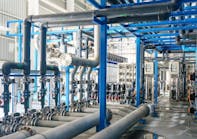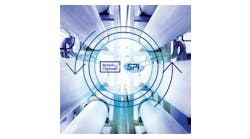In the commonly used bidding procedures for water pumps, sufficient attention is usually not given to the following important subjects:
- The first critical issue is the optimum water pump selection. The selected water pump can usually handle the assigned job, but sometimes it is not the best available option. More care should be taken that the best possible water pump is selected through the bidding process. For example, the selected water pump should usually offer the highest efficiency at the "Best Efficiency Point" (BEP) with the operating range as close as possible to the BEP.
- The vendor experiences, or the water pump model reference check, require more care than what usually is exercised. The reliability, high quality manufacturing and trouble-free long-term operation are not the result of theoretical or textbook concepts. They depend on manufacturing and quality-control capabilities, operational experiences and successful references rather than theoretical designs or engineering/sale capabilities.
- The application details and the operational experiences. A water pump shows different behavior and performance in different systems. In other words, the application details (the details of the water pumping service) can affect both the water pump performance and the water pump reliability. Unfortunately, in many cases, water pumps are purchased by pump-purchasers (or package-engineers) as isolated equipment without sufficient attention to the operational details and the experiences gained from the water pump operations in the similar services (and operational details).
There is a trend toward cost reduction within many water pump manufacturers which sometimes could be damaging for all involved parties. This trend within many water pump manufacturer teams has originated from different sources, but mainly from the selection of the pump manufacturer based on the lowest price. This wrong practice has been exercised by some purchasers for many years. As a result of this trend, proper specification and all required details should be noted for each pump and every single requirement should be raised, discussed and confirmed by pump manufacturers in a proper format to make sure that all requirements are considered and all associated costs are included in the proposal price. Otherwise, it may result in long (sometime intense) discussions after a water pump order.
Good pieces of information, which should be evaluated in the pump bidding process, are the pump shaft diameter, the pump shaft length and the bearing details, including bearing sizes. The pump shaft slenderness ratio (shaft-length/shaft-diameter) is an important parameter to evaluate the pump performance and reliability. A low value of the pump shaft slenderness ratio can reduce the pump shaft deflections, the stresses and the pump vibrations. The larger and better bearings will last longer. Regarding the small (or medium) size water pumps, which use rolling-element bearings, the bearing isolators (usually non-contacting labyrinth seal type) are always preferred to the bearing lip seals.
The self-priming pumps are nearly always preferred for applications which require priming features. These pumps are capable of freeing themselves of entrained air/gas and resuming normal pumping. Usually, these pumps have a section as an integral part of the pump casing to contain a volume of water sufficient for proper priming. If a self-priming pump is not employed, a proper priming method could be required. The priming tank arrangement might be a good option for some applications. The priming tank usually contains three to four times the volume of water in the suction line.
Pump impeller assembly
The closed type impeller is more efficient than the other impeller designs, such as semi-open impeller designs, since it properly contains the flow of water. This design is also mechanically more robust and more reliable. The closed type impeller is the selected impeller for many water services, particularly the critical water application.
The closed type impellers usually use wear rings to limit the clearance and to reduce the water re-circulation. As the wear rings degrade, the clearance will open, the water re-circulation will significantly be increased and the pump efficiency will be considerably reduced. This problem can be identified by monitoring the performance of a water pump. If the performance is dropped and the water pump efficiency is reduced below a certain level, this could be an indication that the pump wear rings should be replaced with new ones.
The differential pressure of a centrifugal pump can be at its maximum when the pump is operating at the shutoff point. The maximum radial force acting on the impeller could be 12 to 45 percent of the maximum differential pressure multiplied by the "impeller diameter × impeller width." This maximum radial force could be a limiting factor for a water pump design. In addition, the pump shaft defection should usually be limited to a value often less than 0.04 mm (sometimes less than 0.02 mm) for the worse condition, which is in most cases for operation at the shutoff point.
In horizontal end-suction pumps (overhung style pumps) both bearings are located on one side of the impeller. In other words, the impeller assembly uses a cantilever design. The deflection limits, the strength requirements and the rotordynamics (and mechanical) considerations for some large water applications could prevent an overhung pump design from being employed above a certain size and pressure combination. For above certain limits, a between-bearing (BB) pump should be used.
For small size water pumps, the commonly used bearing type is the ball-bearing, usually the single-row, deep-groove ball-bearing. Some modern water pump designs tend to use the duplex arrangement of single-row angular-contact bearings instead of the double-row bearings. The back-to-back bearing arrangement is commonly used since it can offer a great angular rigidity and better accept the tiling moments. Sometimes, for large radial loads, cylindrical roller-element bearings may be used. For large water pumps, journal bearings (the sleeve type or the tilting-pad type) are employed.
Pump seal
The pump seal is responsible for most unscheduled shutdowns of water pumps. The seal maintenance costs through the pump life are also the most expensive cost associated with the pump operation and maintenance. As a rough estimate, approximately $1,000-$8,000 (on average) should be spent for a pump mechanical seal replacement. Some pumps may require the pump mechanical replacement every one to three years. The cartridge seal design is always preferred to other seal designs such as the component seal because it is simpler, safer and more reliable. The cartridge seals are available for wide ranges of services and applications (for nearly all types of seal).
Nowadays, the "packing" is not common and mechanical seals should usually be employed in water pumps. The old-fashioned "packing" offered some well-known disadvantages, such as an efficiency penalty, constant water leakage, regular maintenance requirement, high rate of wear, frequent unscheduled shutdowns and many other operational issues.
A thin film of water should be provided between the rotating face and the stationary face of the pump mechanical seal to offer some lubrication and cooling.
Often, flushing water from a suitable source should be used, since sometimes pumped water, if employed without proper processing (for the flushing), can cause problems. For example, high temperature, any containment/solid, chemical traces, dirt, etc. could result in serious damage to the seal. Sometimes, flushing water from an external source should be used. The flushing is piped from a very reliable source at a pressure higher than the pressure of pumped water at the seal location. For some water services, an external flushing source may not be available or suitable and the high pressure pumped water at the discharge nozzle of the pump could be used for the flushing after some processing such as the cooling (by a small heat exchanger), filtration/separation (by a filter/separator), pressure adjustment, etc.
In any mechanical seal, there is a requirement for the closing force to the seal faces during the transient operation (for example, start-up or shutdown), which is provided by the spring or bellows. Traditionally, a series of springs have been used to provide an even loading. A recommended design is the metal bellows which are made from a series of thin metal discs welded together to form a leak-tight configuration suitable for aggressive/critical water services. The material selection of the seal components is extremely important.
Vertical pumps
Vertical inline pumps are compact, simple, cost-effective and popular options for some small (and medium) size water applications. They are commonly employed for revamp or renovation projects where there are limits on the footprint and budgets.
In some simple vertical inline water pump train designs, which were employed previously, the pump impeller(s) and shaft were solely supported by the electric motor driver at the top (no pump bearing). These simple designs have caused some issues and currently are not popular except for small and low-cost applications. Vertical inline pumps usually cannot achieve a good reliability. A major disadvantage of the vertical inline pumps is that the NPSH required is often greater compared to most end-suction pump designs. There is obviously an additional route from the suction flange to the impeller which results in more friction, less efficiency and an additional NPSH requirement.
Vertical sump pumps are commonly used in many sumps (tanks, vessels, reservoirs or similar), where the sump pump is suspended from the top. The electric motor driver is usually installed at the top of the sump on an assembly (or on a base-plate) which practically covers the sump (that could be beneficial from a safety point of view). This vertical pump can use the same impeller and casing as the suction-end pumps. The discharge nozzle on the pump casing is usually horizontal and most often discharges into an elbow that is connected to a vertical pipe.
Another pump design is the submersible pump which is a closely coupled pump and electric-motor that can be located and operated while immersed in the pumped water. The submersible pump design can offer a compact package and good flexibility. A submersible pump can be used in a sump (a well, a vessel, a tank, a reservoir or similar) for temporary, portable, mobile or moving applications. Also, there could be a possibility to change the location and the elevation of a submersible pump. For example, a set of slide rails with special pump connections (or flanges) can be used in a way that allows a submersible pump to change the elevation.
The vertical sump pumps are usually specified for ordinary, low-depth sumps (or vessel/tank applications) over the submersible pumps which are employed for special cases. The first reason could be the limited options for the monitoring and the inspection (vibration, noise, electric motor overheating and other) of submergible pumps. The monitoring, operation and maintenance of vertical sump pumps can more easily be implemented compared to submersible pumps because there is more access over a vertical sump pump, particularly the electric motor driver, the transmission and some other systems.
The second reason is the electric motor and many systems (and accessories) of submersible pumps are relatively special and consequently more expensive. The compact and complicated designs of the submersible pumps require special considerations for the motor and pump close interactions, the protection of package and complex systems for a complete piece of machine submerged in water. To better explain this case, for comparable designs and materials, submersible pumps should be more expensive for purchase as well as operation/maintenance (higher CAPEX, or capital expenses, and higher OPEX, or operation expenses). Submersible pumps are special pumps which should only be employed in the right applications.
Vertical can pumps are popular pumps for special services such as low NPSH applications. This pump design can reduce the NPSH required by lowering the first stage impeller into a lower suction can, usually with the lowest possible elevation.
Sometimes, mixed-flow impellers or axial impellers can be used in vertical pumps. The performance curves of these pumps could be different with conventional pumps; particularly the curve would be relatively steep and the shutoff head could be much more than the head at the "Best Efficiency Point" (BEP). The shutoff head could be two to two and a half of the BEP head (for axial impellers even three times or more). These pumps usually require a bypass to avoid the driver overloading when operating points move toward the shutoff points (higher head and lower flow).
Amin Almasi is a rotating machine consultant in Australia. He is chartered professional engineer of Engineers Australia (MIEAust CPEng – Mechanical) and IMechE (CEng MIMechE) in addition to a M.Sc. and B.Sc. in mechanical engineering and RPEQ (Registered Professional Engineer in Queensland). He specializes in rotating machines including compressors, gas turbines, steam turbines, engines, pumps, condition monitoring and reliability. Almasi is an active member of Engineers Australia, IMechE, ASME, and SPE. He has authored more than 100 papers and articles dealing with rotating equipment, condition monitoring and reliability.


